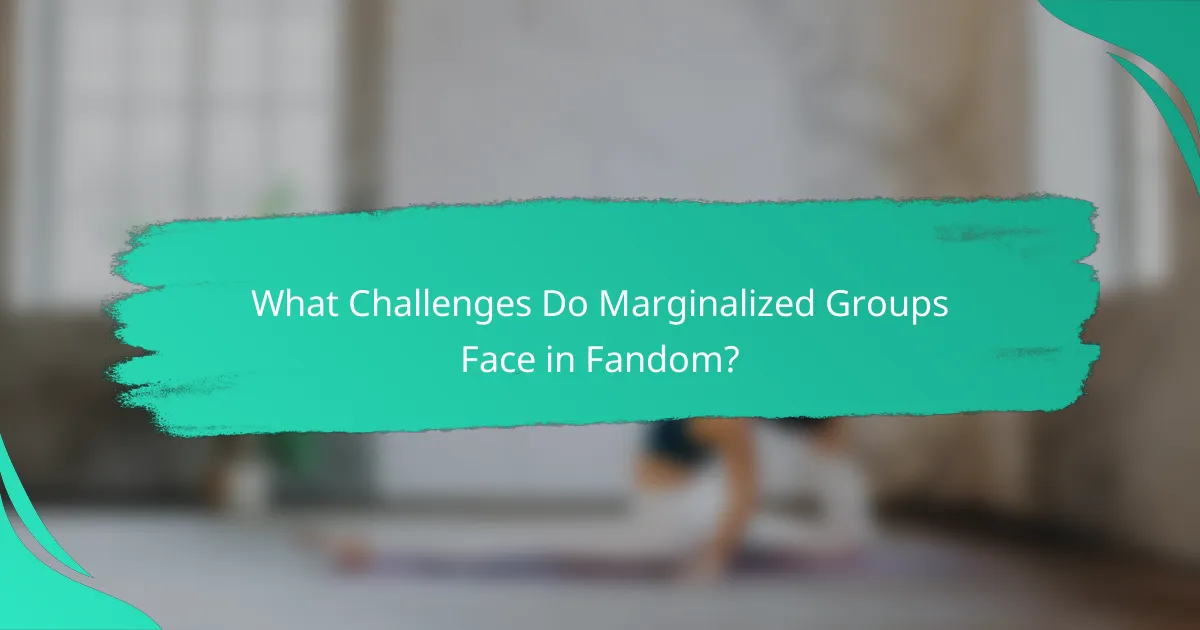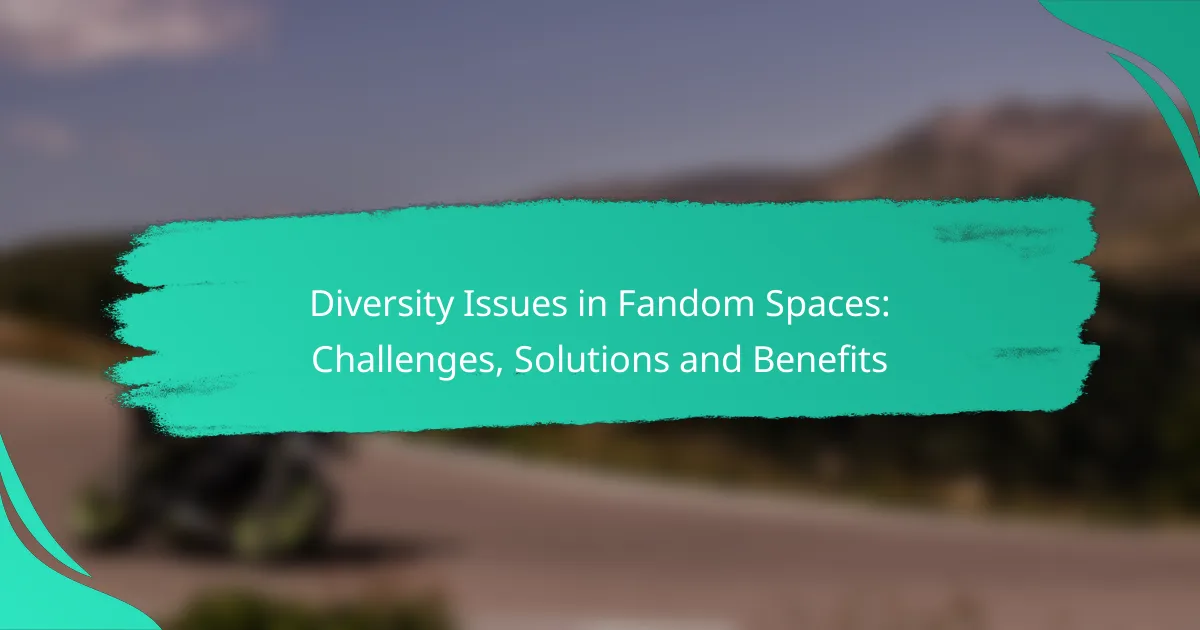Diversity issues in fandom spaces present significant challenges, particularly for marginalized groups who often face exclusion and harassment. To create a more inclusive environment, it is essential to implement strategies that promote diverse representation and support underrepresented voices. By fostering collaboration and education within these communities, fandoms can become welcoming spaces that celebrate a variety of perspectives and experiences.

What Are the Main Solutions to Diversity Issues in Fandom Spaces?
Addressing diversity issues in fandom spaces requires a multi-faceted approach that includes establishing inclusive guidelines, ensuring diverse representation in media, supporting marginalized voices, organizing collaborative events, and implementing education programs. These solutions not only enhance community engagement but also foster a more welcoming environment for all fans.
Inclusive community guidelines
Creating inclusive community guidelines is essential for fostering a safe and welcoming environment in fandom spaces. These guidelines should clearly outline acceptable behavior, promote respect for all members, and discourage discrimination based on race, gender, sexuality, or ability. Regularly revisiting and updating these guidelines can help maintain a positive atmosphere.
For example, fandoms can implement a code of conduct that includes specific consequences for harassment and discrimination. This not only sets clear expectations but also empowers community members to report violations without fear of retaliation.
Diverse representation in media
Diverse representation in media is crucial for reflecting the varied experiences of fans. This can involve promoting content that features characters from different backgrounds, cultures, and identities. By showcasing a wide range of perspectives, media can resonate with a broader audience and encourage inclusivity within fandoms.
Fandoms can support diverse media by actively seeking out and sharing works created by underrepresented groups. This can include independent films, books, and art that highlight diverse narratives, thus enriching the community’s cultural landscape.
Support for marginalized voices
Supporting marginalized voices within fandom spaces is vital for creating an inclusive environment. This can involve amplifying the work of creators from underrepresented backgrounds and providing platforms for their stories. Encouraging discussions around their experiences can help foster understanding and solidarity among fans.
Fandoms can create mentorship programs or workshops that focus on empowering marginalized creators. By providing resources and opportunities, these initiatives can help elevate diverse voices and ensure they are heard and valued.
Collaborative events and initiatives
Organizing collaborative events and initiatives can bring together diverse groups within fandoms, promoting unity and understanding. These events can range from conventions and panels to online meetups that focus on specific themes related to diversity and inclusion.
For instance, hosting panels that feature diverse creators discussing their work can provide valuable insights and foster connections among fans. Additionally, collaborative art projects or fan fiction contests can encourage participation from a wider range of voices.
Education and awareness programs
Implementing education and awareness programs is essential for addressing diversity issues in fandom spaces. These programs can provide resources on topics such as cultural sensitivity, intersectionality, and the importance of representation. By educating fans, communities can cultivate a more informed and empathetic environment.
Fandoms can host workshops, webinars, or discussion groups that focus on these topics, encouraging open dialogue and learning. Providing access to literature and resources on diversity can further enhance understanding and promote positive change within the community.

How Can Fandom Spaces Promote Inclusivity?
Fandom spaces can promote inclusivity by actively creating environments where all individuals feel welcome and valued. This involves implementing practices that support diverse voices and perspectives within the community.
Creating safe spaces
Safe spaces are environments where individuals can express themselves without fear of judgment or harassment. Fandoms can establish these spaces by setting clear guidelines for behavior and encouraging open dialogue about inclusivity.
Examples of safe spaces include moderated forums, dedicated chat rooms, or events specifically designed for underrepresented groups. These areas should prioritize respect and understanding, allowing participants to share their experiences and connect with others.
Encouraging diverse content creation
Encouraging diverse content creation involves supporting creators from various backgrounds and experiences. Fandoms can highlight and promote works that reflect different cultures, identities, and perspectives, enriching the community’s overall narrative.
Communities can organize events like writing contests or art showcases that specifically invite submissions from diverse creators. Providing resources and mentorship can also help emerging voices gain visibility and recognition in the fandom.
Implementing anti-harassment policies
Implementing anti-harassment policies is crucial for maintaining a welcoming environment in fandom spaces. These policies should outline unacceptable behaviors and the consequences for engaging in them, ensuring that all members understand their rights and responsibilities.
Fandoms can establish reporting mechanisms that allow individuals to safely report harassment. Regular training for moderators and community leaders on recognizing and addressing harassment can further strengthen these policies, fostering a culture of accountability and respect.

What Challenges Do Marginalized Groups Face in Fandom?
Marginalized groups in fandom often encounter significant barriers that hinder their full participation and enjoyment. These challenges include exclusion from mainstream narratives, harassment, and a lack of representation in the media and community spaces.
Exclusion from mainstream narratives
Exclusion from mainstream narratives occurs when the stories and characters that dominate popular culture do not reflect the diversity of the audience. This can lead to feelings of alienation among fans who do not see themselves represented in the media they consume.
For example, many marginalized groups may find that their experiences and identities are either misrepresented or completely absent from popular franchises. This lack of visibility can discourage engagement and diminish the sense of belonging within the fandom.
Harassment and toxicity
Harassment and toxicity are prevalent issues in many fandom spaces, particularly for individuals from marginalized backgrounds. These fans often face targeted abuse, including threats and derogatory comments, which can create a hostile environment.
Such negative experiences can deter marginalized individuals from participating in discussions or events, leading to further isolation. It’s crucial for fandom communities to establish clear guidelines against harassment and to actively support those who are targeted.
Lack of representation
The lack of representation in fandoms means that characters and stories often fail to include diverse perspectives. This absence can perpetuate stereotypes and reinforce harmful narratives that marginalize certain groups.
To combat this, fans can advocate for more inclusive storytelling by supporting creators who prioritize diversity. Engaging in discussions about representation and calling out problematic portrayals can also help foster a more inclusive environment within fandoms.

What Benefits Arise from Embracing Diversity in Fandom?
Embracing diversity in fandom brings numerous benefits, including enhanced creativity, broader audience engagement, and stronger community bonds. These advantages not only enrich the fan experience but also foster a more inclusive environment for all participants.
Enhanced creativity and innovation
Diverse perspectives in fandom lead to greater creativity and innovation. When individuals from various backgrounds contribute their unique ideas, the result is often a richer tapestry of storytelling and artistic expression.
For example, incorporating different cultural narratives can inspire new plotlines or character developments that resonate with a wider audience. This creative synergy can also lead to collaborative projects that push the boundaries of traditional fandom.
Broader audience engagement
Engaging a diverse fanbase allows for broader audience participation and interest. When fandoms reflect a variety of identities and experiences, they attract individuals who may have previously felt excluded.
This inclusivity can be achieved through targeted outreach, diverse representation in media, and events that celebrate various cultures. By fostering an environment where everyone feels welcome, fandoms can significantly increase their membership and participation rates.
Stronger community bonds
Diversity strengthens community bonds by encouraging empathy and understanding among fans. When individuals share their experiences and stories, it fosters connections that transcend superficial differences.
Creating spaces for dialogue, such as forums or social media groups, can help facilitate these connections. Additionally, organizing events that celebrate diversity, such as cultural festivals or themed conventions, can further solidify these community ties.

What Frameworks Support Diversity in Fandom?
Frameworks that support diversity in fandom focus on creating inclusive environments where all participants feel valued and represented. These frameworks often include guidelines, best practices, and community standards that promote equitable access and participation across various fandom spaces.
Best practices for event organizers
Event organizers should prioritize inclusivity by ensuring diverse representation in panels, workshops, and activities. This can be achieved by actively seeking out speakers and participants from various backgrounds, including different ethnicities, genders, and abilities.
Additionally, providing accessibility options, such as sign language interpreters or wheelchair access, is crucial. Organizers should also create a code of conduct that clearly outlines expectations for respectful behavior, helping to foster a safe environment for all attendees.
Guidelines for content creators
Content creators can support diversity by incorporating a wide range of perspectives in their work. This includes representing characters and stories from underrepresented groups, which can resonate with a broader audience and enrich the fandom experience.
Creators should also be mindful of cultural sensitivity and avoid stereotypes. Engaging with diverse collaborators or consultants can enhance authenticity and ensure respectful representation. Regularly seeking feedback from diverse audiences can further refine content and promote inclusivity.

How Do Different Fandoms Address Diversity Issues?
Different fandoms tackle diversity issues through a variety of approaches, including community guidelines, inclusive representation, and active engagement with marginalized voices. These strategies aim to create welcoming environments that celebrate diverse backgrounds and perspectives.
Community Guidelines and Policies
Many fandoms establish community guidelines that promote inclusivity and respect among members. These guidelines often include rules against harassment, discrimination, and hate speech, fostering a safer space for all participants. For example, platforms like Reddit and Discord have specific policies that address toxic behavior and encourage constructive dialogue.
Implementing these guidelines requires active moderation and community involvement. Fandoms can benefit from appointing diverse moderators who understand the nuances of different cultures and identities, ensuring fair enforcement of the rules.
Inclusive Representation in Media
Fandoms often advocate for inclusive representation in the media they consume, pushing creators to include diverse characters and storylines. This can lead to a richer narrative experience and help fans from various backgrounds feel seen and valued. For instance, shows like “Steven Universe” and “Star Trek: Discovery” have been praised for their representation of [censured] characters and people of color.
Fans can support this movement by engaging with and promoting content that highlights diversity. This includes sharing fan art, writing reviews, and participating in discussions that celebrate inclusive storytelling.
Engagement with Marginalized Voices
Engaging with marginalized voices is crucial for fostering diversity within fandoms. This can involve inviting creators from underrepresented backgrounds to speak at conventions, participate in panels, or collaborate on projects. Such engagement not only enriches the community but also provides valuable perspectives that can influence future content.
Fandoms should actively seek out and amplify these voices through social media campaigns, crowdfunding for projects, or creating spaces for discussion. This not only supports marginalized creators but also educates the broader community on the importance of diversity in storytelling.
